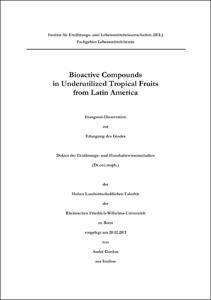Gordon, André: Bioactive Compounds in Underutilized Tropical Fruits from Latin America. - Bonn, 2012. - Dissertation, Rheinische Friedrich-Wilhelms-Universität Bonn.
Online-Ausgabe in bonndoc: https://nbn-resolving.org/urn:nbn:de:hbz:5n-29864
Online-Ausgabe in bonndoc: https://nbn-resolving.org/urn:nbn:de:hbz:5n-29864
@phdthesis{handle:20.500.11811/5127,
urn: https://nbn-resolving.org/urn:nbn:de:hbz:5n-29864,
author = {{André Gordon}},
title = {Bioactive Compounds in Underutilized Tropical Fruits from Latin America},
school = {Rheinische Friedrich-Wilhelms-Universität Bonn},
year = 2012,
month = oct,
note = {A vast number of plant species originating from Latin America bear delicious fruits, which are hardly known beyond its regional borders. Many of these underutilized fruits may offer a great potential for an intensified commercial use. Generally, the prerequisite for an enhanced perception of underutilized fruits by the consumer or the industry is a comprehensive knowledge on their value adding components. Hence, aim of this thesis is to shed light on physiologically important constituents of selected fruits and to disclose their bioactive potential by investigating their antioxidant capacity.
Fruits of Euterpe oleracea (açaí), Anacardium occidentale (cashew apple), and Myrtillocactus schenckii (garambullo) were investigated on changes in amounts of phenolic compounds and the antioxidant capacity at different maturity stages.
For the first time, a comprehensive chemical characterization was performed on ripe fruits of Clidemia rubra. The identification and quantification of the phenolic components showed high concentrations of anthocyanins and various flavonol glycosides. The anthocyanin cyanidin 3-O-rutinoside could be isolated from Clidemia rubra berries in an appreciable purity (98%, measured by HPLC at 280 nm).
The Amazonian fruits of Byrsonima crassifolia (muruci), Syzygium cumini (jambolão), Psidium guineense (araçá), and Pouteria macrophylla (cutite) were subjected to a qualitative analysis of polyphenolic ingredients. Different compounds like gallotannins, ellagitannins, quinic acid gallates, flavanonols, flavonols, and proanthocyanidins were detected.
On the basis of an intervention study it was observed to what extend bioactive substances potentially exert effects on the antioxidative status and oxidative stress in human. Data about the influence of fruit or fruit product consumption in vivo are inconsistent to date and depend often on singly measured parameters. In this crossover study, twelve subjects ingested a fruit juice rich in vitamin C and polyphenols composed of açaí, Andean blackberries, and camu camu. A significant increase was only denoted for plasma levels of ascorbic acid. All other parameters (DNA single strand breaks, F2-isoprostanes, TEAC, total phenolic content, triglycerides, vitamin E, β-carotene, uric acid, cholesterol) demonstrated no significant alterations. However, TOSC results of the intervention group did not show a significant decrease of the antioxidant capacity in plasma as it was observed for the control group. Thus, fruit juice consumption might have a stabilizing effect on the plasma antioxidant capacity. In addition, reducing substances were found in plasma after bolus ingestion of the juice using HPLC-CEAD, which suggests the formation of potent antioxidative metabolites.
Further, gallic acid and a coumaric acid isomer were detected by HPLC-MS analysis after fruit juice consumption. These phenolic acids were either directly bioavailable from the fruit juice or they represent degradation products from higher molecular polyphenols.},
url = {https://hdl.handle.net/20.500.11811/5127}
}
urn: https://nbn-resolving.org/urn:nbn:de:hbz:5n-29864,
author = {{André Gordon}},
title = {Bioactive Compounds in Underutilized Tropical Fruits from Latin America},
school = {Rheinische Friedrich-Wilhelms-Universität Bonn},
year = 2012,
month = oct,
note = {A vast number of plant species originating from Latin America bear delicious fruits, which are hardly known beyond its regional borders. Many of these underutilized fruits may offer a great potential for an intensified commercial use. Generally, the prerequisite for an enhanced perception of underutilized fruits by the consumer or the industry is a comprehensive knowledge on their value adding components. Hence, aim of this thesis is to shed light on physiologically important constituents of selected fruits and to disclose their bioactive potential by investigating their antioxidant capacity.
Fruits of Euterpe oleracea (açaí), Anacardium occidentale (cashew apple), and Myrtillocactus schenckii (garambullo) were investigated on changes in amounts of phenolic compounds and the antioxidant capacity at different maturity stages.
For the first time, a comprehensive chemical characterization was performed on ripe fruits of Clidemia rubra. The identification and quantification of the phenolic components showed high concentrations of anthocyanins and various flavonol glycosides. The anthocyanin cyanidin 3-O-rutinoside could be isolated from Clidemia rubra berries in an appreciable purity (98%, measured by HPLC at 280 nm).
The Amazonian fruits of Byrsonima crassifolia (muruci), Syzygium cumini (jambolão), Psidium guineense (araçá), and Pouteria macrophylla (cutite) were subjected to a qualitative analysis of polyphenolic ingredients. Different compounds like gallotannins, ellagitannins, quinic acid gallates, flavanonols, flavonols, and proanthocyanidins were detected.
On the basis of an intervention study it was observed to what extend bioactive substances potentially exert effects on the antioxidative status and oxidative stress in human. Data about the influence of fruit or fruit product consumption in vivo are inconsistent to date and depend often on singly measured parameters. In this crossover study, twelve subjects ingested a fruit juice rich in vitamin C and polyphenols composed of açaí, Andean blackberries, and camu camu. A significant increase was only denoted for plasma levels of ascorbic acid. All other parameters (DNA single strand breaks, F2-isoprostanes, TEAC, total phenolic content, triglycerides, vitamin E, β-carotene, uric acid, cholesterol) demonstrated no significant alterations. However, TOSC results of the intervention group did not show a significant decrease of the antioxidant capacity in plasma as it was observed for the control group. Thus, fruit juice consumption might have a stabilizing effect on the plasma antioxidant capacity. In addition, reducing substances were found in plasma after bolus ingestion of the juice using HPLC-CEAD, which suggests the formation of potent antioxidative metabolites.
Further, gallic acid and a coumaric acid isomer were detected by HPLC-MS analysis after fruit juice consumption. These phenolic acids were either directly bioavailable from the fruit juice or they represent degradation products from higher molecular polyphenols.},
url = {https://hdl.handle.net/20.500.11811/5127}
}






